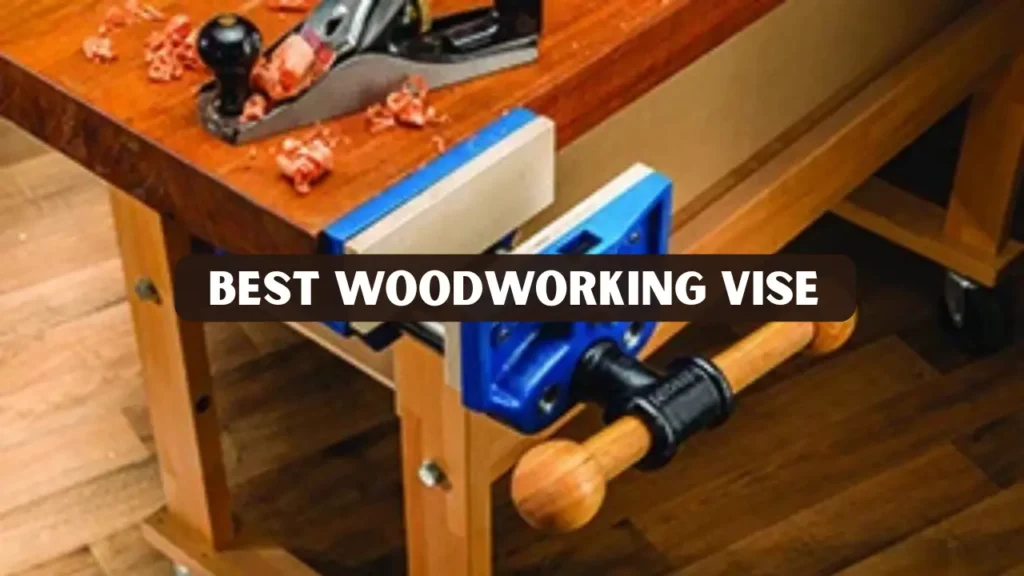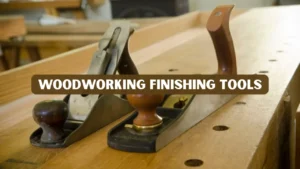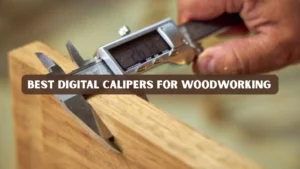A woodworking vise is a specialized tool designed to firmly hold wood pieces in place while you cut, carve, sand, plane, or join them. It attaches to your workbench and provides the stability needed for accurate and safe woodworking. Unlike metalworking vises, these tools use wider jaws and smoother surfaces to protect wood from dents and scratches.
Professionals, hobbyists, and DIY woodworkers all rely on a secure grip because stability is the foundation of clean, precise work. Without it, even the most skilled craftsperson will struggle to achieve fine results, making a vise a crucial part of both small and large woodworking setups.
Key Takeaways
- A woodworking vise is one of the most essential tools for stabilizing wood during cutting, planing, drilling, and joinery.
- Choosing the right model depends on jaw width, clamping power, quick release mechanism, and installation style.
- Top picks for both beginners and professionals include Yost, Eclipse, Pony Jorgensen, and IRWIN.
- This guide covers real-world usage, expert recommendations, installation tips, and the top seven best vises available in 2025.
Why a Woodworking Vise Is Essential in Every Workshop
A vise is not just an accessory. It is a fundamental part of a functional workbench that enhances craftsmanship and productivity.
- Improved Stability: Wood does not shift or wobble while cutting or shaping, which ensures reliable results.
- Cleaner, Safer Cuts: Consistent pressure reduces risks of slips and accidental tool injuries.
- Better Precision: Perfect for joinery, chiseling, drilling, sanding, trimming, and planing work.
- Faster Workflow: Quick release vises help you reposition wood instantly and boost efficiency.
- Supports All Skill Levels: From beginner DIYers to professional carpenters, everyone benefits from a solid vise.
Different Types of Workbench Vises
Understanding different types of vises helps you choose one suited to your woodworking style and project needs.
1. Front Vise or Face Vise
A front vise is mounted on the front side of your workbench, typically near the left edge for right-handed users. It is one of the most common types of vises in woodworking because it provides excellent accessibility and stability for a wide range of tasks.
Ideal for:
- Jointing: Holds boards securely while you plane or smooth edges to create tight, precise joints.
- Sanding edges: Keeps the wood steady so you can sand evenly without slipping.
- Light and medium woodworking tasks: Perfect for small assembly, cutting, or shaping projects.
Many modern front vises include quick release levers, which allow you to open or close the jaws rapidly without turning the handle multiple times. This feature is especially useful when working on multiple boards or switching between tasks frequently.
2. Tail Vise
A tail vise is installed on the end of your workbench, typically opposite the front vise, and is designed to work in conjunction with bench dogs; small pegs that fit into holes on the workbench surface. This setup allows you to clamp long boards securely along the length of the bench, making it easier to plane, sand, or join them without movement.
Best for:
- Long boards: Holds lengthy pieces firmly in place, preventing wobbling or shifting.
- Planing: Keeps the wood stable for smooth, even strokes with a hand plane.
- Securing wood flat on the bench: Ensures boards remain flush and level during cutting, sanding, or assembly.
Tail vises are particularly popular among furniture makers and cabinet builders, as they allow precise alignment and support for boards that are too long to manage with a front vise alone.
3. Leg Vise
- Mounted on a bench leg, this vise offers maximum clamping force and durability. It is built to handle large, heavy boards without slipping, making it ideal for serious woodworking projects.
- It is highly effective for heavy duty woodworking tasks. Many woodworkers prefer this type of vise when working on furniture or large cabinetry because it provides unmatched stability.
4. Twin Screw Vise
- Prevents racking and supports extra wide boards. This ensures the wood remains perfectly aligned during cutting, planing, or shaping, reducing errors and material waste.
- Perfect for joinery work and cabinet making. Its stability allows precise measurements and tight-fitting joints, which is essential for professional-quality furniture and cabinetry projects.
Portable Bench Vise
A small vise that clamps onto movable or temporary benches. It is lightweight and easy to set up, making it convenient for short-term projects or limited workspace.
Great for:
- Small workshops: Saves space while still providing a secure hold for light woodworking tasks.
- Beginners: Offers an affordable and simple way to get started with basic projects without investing in a full-size bench.
- Traveling woodworkers: Easy to carry and attach anywhere, allowing woodworking on the go or at remote job sites.
How to Choose the Right One
Choosing the perfect vise ensures smoother workflow, increased safety, and higher accuracy.
- Jaw Width: Larger jaws support more diverse projects. A wider jaw allows you to clamp bigger boards securely, making it easier to handle furniture parts and wide panels.
- Clamping Pressure: High pressure vises hold wood firmly without slipping. Adequate clamping force ensures precise cuts and smooth planing without damaging the workpiece.
- Quick Release Mechanism: A useful feature if you frequently reposition workpieces. It saves time and improves workflow, especially when handling multiple boards or repetitive tasks.
- Mounting Style: Choose between front mounted, under bench, or surface mounted. The mounting type affects accessibility, stability, and the types of projects you can comfortably handle.
- Material Quality: Look for cast iron bodies, steel guide bars, and durable screw mechanisms. High-quality materials extend the life of the vise and maintain consistent performance over years of woodworking
Top 7 Best Vises for Your Workshop
Based on performance, durability, and user satisfaction, here are the seven most recommended vises for 2025.
1. Yost Vises M7WW Rapid Action Woodworking Vise
A top choice for beginners and intermediate woodworkers. It provides smooth action and fast adjustments. Ideal for smaller workshops and everyday tasks where consistent clamping is important.
2. Yost Vises F10WW 10 Inch Front Vise
Known for its heavy-duty clamping power. Excellent for large woodworking projects, furniture making, and repeated daily use. Its robust construction ensures long-lasting performance, providing stability even when working with thick or irregularly shaped boards.
3. Pony Jorgensen 27091 Medium Duty Woodworker Vise
Reliable for shaping, sanding, sawing, and assembly tasks. Its balanced build and smooth performance make it a trusted workshop tool. Additionally, its durable construction ensures consistent clamping pressure, which helps maintain accuracy during intricate woodworking projects.
4. Groz 7 Inch Woodworking Front Vise
A great choice for beginners wanting a dependable and affordable tool. Compact, sturdy, and simple to install. Its straightforward design allows new woodworkers to achieve accurate cuts and smooth finishes without a steep learning curve.
5. IRWIN 226361 6.5 Inch Vise
Ideal for small workbenches and DIYers. It has a reliable grip and straightforward installation process. Its compact size makes it perfect for limited spaces while still providing enough clamping strength for everyday woodworking projects.
6. Eclipse Quick Release 10 Inch Vise
A preferred choice among professionals. The quick release mechanism saves significant time during complex or repetitive tasks. Its sturdy construction and smooth operation make it ideal for high-volume workshops where efficiency and precision are critical.
7. HFS Heavy Duty Bench Vise
This versatile vise works for both woodworking and light metal tasks. The swivel base adds flexibility for awkward workbench angles. Its heavy-duty construction ensures long-lasting durability, making it suitable for a wide range of projects in both professional and home workshops.
How to Install
Installing your vise correctly ensures smooth performance and long term durability.
Steps to Install:
- Choose the bench location, typically front left for right-handed users. This ensures easy access while working and provides optimal leverage for clamping.
- Mark and drill mounting holes precisely. Accurate placement prevents misalignment and ensures the vise sits flush with the bench surface.
- Attach the vise using sturdy bolts to prevent wobbling. Using high-quality bolts and washers increases stability and extends the lifespan of the installation.
- Align jaw faces with the bench edge for maximum support. Proper alignment ensures even pressure on the wood and prevents uneven cuts or damage.
- Test movement to confirm smooth opening and closing. Adjust if necessary to eliminate any binding, ensuring safe and efficient operation during all woodworking tasks.
A well installed vise not only improves your workflow but also extends the lifespan of your bench setup.
Real World Case Studies
- A beginner woodworker upgraded from clamps to a Yost M7WW vise and immediately achieved cleaner cuts and faster project completion. The stability improved accuracy in joinery tasks.
- A professional furniture maker switched to an Eclipse quick release vise and reduced sanding and edge planing time by nearly 30 percent due to faster board repositioning.
Common Mistakes to Avoid
- Over tightening, which can dent softer woods. Applying too much pressure may damage the workpiece and reduce the quality of your finish.
- Installing the vise too low or off center. Poor placement can make clamping awkward and decrease overall stability during use.
- Using bare metal jaws without protective wooden liners. This can leave marks or scratches on delicate wood surfaces, affecting your project’s appearance.
- Ignoring lubrication and routine maintenance. Lack of care can cause the screw and guide bars to seize, reducing the lifespan of your vise.
- Choosing the wrong jaw size for the project. A jaw that is too small or too large can compromise clamping strength and make certain tasks more difficult or unsafe.
Maintenance Tips for Long Vise Life
- Lubricate screws and guide bars every few weeks. Regular lubrication ensures smooth operation and prevents wear on moving parts.
- Keep dust and sawdust out of moving parts. Accumulated debris can cause binding and reduce clamping efficiency over time.
- Replace wooden jaw liners when worn. Fresh liners maintain a secure grip and protect your workpieces from dents and scratches.
- Tighten mounting bolts annually. This prevents wobbling and keeps the vise firmly attached to the bench.
- Clean surfaces to avoid rust buildup. Regular cleaning prolongs the life of the vise and maintains reliable performance in any workshop environment.
Conclusion
A woodworking vise is one of the most valuable tools you can add to your workshop. Whether you build small DIY crafts or create professional furniture, the right vise boosts accuracy, safety, and efficiency. The top seven vises listed above include beginner friendly options and heavy duty models for advanced users, giving you plenty of choices for your skill level and project type.
If you are ready to upgrade your workshop setup, explore detailed specifications, compare features, and select the vise that fits your workflow best. With the right vise installed properly and maintained well, your workbench becomes a reliable station for years of productive woodworking.
FAQs
What size vise do I need
For general woodworking, a 7 to 10 inch vise works best. Larger benches may require a 10 to 12 inch vise.
Should I get a quick release vise
Yes, especially if you frequently reposition wood. A quick release mechanism saves significant time during joinery and sanding.
Can one vise handle all woodworking tasks
Most tasks can be handled with a single vise, but heavy duty furniture makers often prefer having both a front vise and a tail vise.
Are vises beginner friendly
Absolutely. Even simple DIY tasks become easier, safer, and more accurate with a vise.
How long do woodworking vises last
A high quality cast iron vise can last 10 to 20 years or more with proper care and maintenance.




